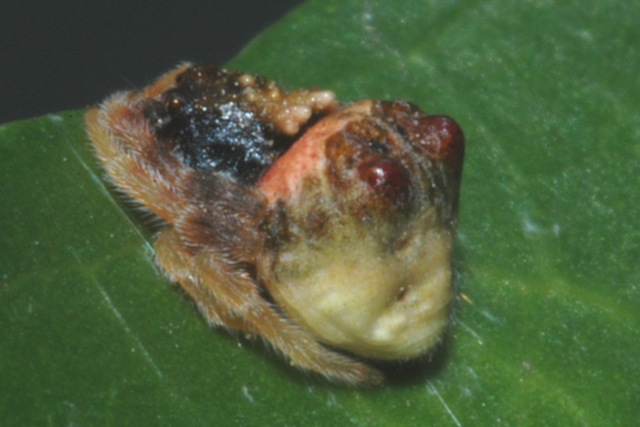Scoundrels – #3
Orb-web spiders build an intricate trap to catch their prey, normally hapless insects; however, there are some spiders in this family, notably the bolas spiders that have almost entirely dispensed with a web. Instead they rely on just a short thread with a blob of sticky silk on the end. This is not merely a half-baked attempt at making a web; the prey capturing apparatus of a spider who simply can’t be bothered to spin a proper web. No, far from it, Bolas spiders know that it’s not what you’ve got it’s how you use it that counts.
The sorry looking ‘web’ is part of a delicious ruse involving the lasso skills of a gaucho and the malodorous abilities of the paussine beetles (see Scoundrels #6). When night falls, the bolas spider (Mastophora spp.) constructs itself a small silken gantry to hang from in order to prepare its trap. It makes its bolas and waits, listening for the faint sound of moth wings on the night air. Should a moth flutter within range, the spider whirls its bolas in the hope of connecting with the moth; however, if it were to rely on chance alone, its bolas at the ready, the spider might be waiting a long time for a moth to flutter within range of its trap, so to tilt the table of fortune in its favour the spider is capable of emitting an odour that has more than a passing resemblance to the pheromones given off by cutworm moths (Nephelodes spp., Lacinipolia spp.)
The male moths get a whiff of this heady odour and make straight for it. As the moth draws closer to the source of the scent, its tiny brain is probably filled with happy thoughts about how all that time spent as a caterpillar is not going to go to waste. He has found a female, he’ll get it on with her and his work will be done. Just as his feeling pretty chuffed with himself the deceptive spider’s whirling bolas connects squarely with his solid thorax. The blob of silk on the end of the bolas sticks tight and the spider draws him in. For this moth, the struggle for survival is over, which is a shame because he was doing so well – he’d survived the horrors of hatching , the lottery of larvalhood and the perils of pupation, just to get caught by a spider that couldn’t even be bothered to build a proper web. Where’s the justice?

The spider goes about digesting the moth from the inside out and when she’s finished she sets her trap again, because there are other moths on the wing and one species, the smoky tetanolita (Tetanolita spp.) is also drawn to the fake promises of mates issuing from the bolas spider’s glands.
Even juvenile bolas spiders are masters of deception. They hang about on the edges of leaves emitting an odour that smells like female flies. Sooner or later, a desperate male fly, his tiny brain addled by thoughts of reproduction, casually scuttles up to the wingless, eight-legged ‘fly’ and tries it on, only to be quickly despatched.
Not only are bolas spiders adept at aggressive mimicry, but they also use defensive mimicry to prevent them from falling prey to their own enemies. Like many invertebrates, they mimic bird-droppings, and for good reason, as there are few animals known to relish this particular type of waste. They sit about on leaves, pretending to be a bit of bird cack and lo and behold, nothing tries to eat them.

For the ingenious deception displayed by the bolas spiders they are worthy of the bronze medal in the scoundrel championships.
Leave a Reply